 |
STRAWBERRY HILL reopens this autumn. First, head to the V&A for its exhibition on Horace Walpole’s house, Britain’s finest example of Georgian Gothic Revival architecture, and his extraordinary art collection.
 |
| Horace Walpole by Joshua Reynolds |
IN THE 17TH CENTURY, there was a fashion among the wealthy for Cabinets of Curiosities to interest and amuse their friends. There could be anything in the little drawers from amber picked up on a foreign shore to Elizabethan miniatures or a fanciful ‘dragon’s’ egg. The rarer or more bizarre the better.
A century later, Horace Walpole, younger son of Britain’s first Prime Minister Sir Robert Walpole, wit, ‘man of letters’ and obsessive collector, went one better. He turned Chopp’d Straw Hall, a modest 1698 coachman’s house on the banks of the Thames at Twickenham, into a Gothic Revival mansion. Strawberry Hill – named after the local fruit fields which fed London’s tables – became a giant cabinet of curiosities.
From now until 4 July, visitors can see just what he collected in Horace Walpole and Strawberry Hill at London’s Victoria and Albert Museum. Bringing together over 250 works owned by him and not seen together since 1842 when they were auctioned by his heir, the exhibition covers the whole spectrum of the arts.
Here are Joshua Reynolds and Van Dyck portraits, delicate works by master watercolourists like Paul Sandby, miniatures by Holbein and Hilliard and exquisite porcelain. There are lovely pieces of furniture, including an opulent Boulle coffer in tortoiseshell, pewter, copper and ormolu and, my particular favourite, a pointy Gothic William S Hallet chair from 1755. In beech wood, painted to imitate ebony – what Walpole called “the true black blood”, it was designed by him and Richard Bentley, a close friend who also helped with ideas for the house itself. It is “ancient looking’, something he aimed for in furniture, but has strange legs which make it look as though it’s standing on tiptoe.
There is also fine sculpture, silverware, stained glass, rare books and manuscripts. Walpole loved ceramics – there were over 600 pieces, some on and some under furniture – and he always took tea out of priceless porcelain. But he also had an eye for the interesting vernacular, like a colourful late 16th-century pharmacy bottle, with the Medici coat of arms.
And among all these beautiful things are his more eccentric acquisitions, which I found fascinating. Walpole appeared at one of his soirées wearing a pair of gloves he believed belonged to James I and a lime-wood cravat carved like lace by the master, Grinling Gibbons. Both are are on display.
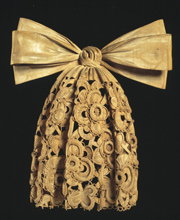 |
|
Cravat carved by Grinling Gibbons |
Here, too, is an Aztec mirror used by Elizabethan magician and astrologer Dr Dee, a lock of hair belonging to Mary Tudor and Cardinal Wolsey’s huge red plate of a hat. I liked the silver gilt bracket clock with faint but loving inscription on its pendulum, ”The most happy…” It was given by Henry VIII to Anne Boleyn.
Walpole’s house was Britain’s first museum and he opened it to the public charging “one guinea. Groups may be no more than four and no children.”. “He believed physical objects were “doorways to the past”,” says exhibition curator Michael Snodin. Because of what’s known as the Great Sale, Horace Walpole’s collection was dispersed throughout the world. “Luckily, the Lewis Walpole Library at Yale University has an inventory made by his descendent and we were able to track much of it down,” says Michael.
“I was particularly excited that we could show Francis I’s armour, which turned up in East Germany, and two flower tubs by Wedgwood which were designed by Walpole’s friend Lady Diana Beauclerk. They illustrate just how wide his interests were.”
Some things have still not been found and Strawberry Hill’s trustees have begun a Treasure Hunt for the dining plates that match those tubs, Henry VIII’s dagger, and refectory table with barley sugar twist legs in ebony with a Sicilian jasper top.
 |
|
Vase with Medici ring c1465-80 |
Strawberry Hill itself is being completely refurbished at a cost of £9million after the World Monuments Fund declared it one of the most endangered houses in the world. It reopens to the public at the end of September by a member of the Royal family.
It is an extraordinary house. As tasteful, yet flamboyant and unique as its owner! Britain’s finest example of Georgian Gothic Revival architecture, it has crenellations, pepperpot towers and long pointy stained glass windows. Built in stone, from a distance it looks as though it’s made of sugar. The entry hall, with a staircase based on one in Rouen cathedral, is like a church cloister with its shadowy light. Walpole called it “gloomth”. In a corner stood a huge Chinese porcelain tub – currently in the V&A exhibition – in which his favourite tabby Selima had drowned, while trying to paw out a goldfish.
“A lot of the house was in grey and black,” explained Andy Ganf, my expert guide. “The fireplaces were often copied from medieval cathedral tombs and the Flemish and medieval stained glass he collected for the windows added to the unusual atmosphere. No wonder he was inspired to write The Castle of Otranto – the first-ever gothic novel – here!”
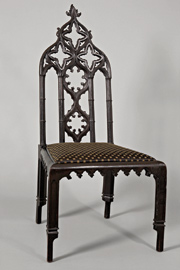 |
|
William Hallett Sr Chair, c1755 |
But when you walk into The Long Gallery, “you go from gloomth to spectacular,” said Andy. The gilded ceiling, with its fan vaulting, is inspired by Henry VII’s chapel in Westminster Abbey. The walls are red damask, showing off his oil paintings magnificently – of his family in order of importance – and mirrors reflect light from the long windows. It’s like coming into the daylight from the twilight. Walpole’s workmen didn’t like it. Faint graffiti on the wall says:”It is very cold in here and there is no heating. 1857”
A lot of the fittings aren’t what they seem. “Much was done in wood and papier mâché,” said Andy Ganf. “Which is why the interiors gradually fell apart. But using watercolours and sketches done during his lifetime, we can put it back as it ought to be.”
There’s so much to see. The Great North Bedchamber with its red damask walls, the Round Room with Robert Adam fireplace. The Tribune, where Walpole kept many of his treasures, is gilded and has lovely stained glass.
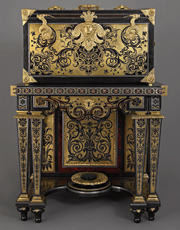 |
|
Coffer on stand c 1710 |
You need a whole day to wander about Walpole’s “little play-thing house”, take tea and browse round the shop. “The gardens are being restored gradually, too,” said Andy. “There will be pots containing the specially created Strawberry Hill rose, you can sit in a replica of his favourite Shell Seat – even buy one for your own home! – and soak up the atmosphere.”
The Victoria and Albert Museum, South Kensington, London. Tel: (020) 7942 2000; www.vam.ac.uk. Further information on the refurbishment on Strawberry Hill and the reopening, www.strawberryhilltrust.org. For more information on visiting Richmond-upon-Thames and Twickenham area, go to www.visitrichmond.co.uk. And watch out for our feature in the London’s Villages series on Richmond and Kingston, in the next issue of BRITAIN magazine, June/July 2010.
Report by Pat Moore.
Images: Portrait of Horace Walpole c1756-7 Joshua Reynolds © Marquess of Hertford, Ragley Hall Warwickshire
Cravat c1690 Grinling Gibbons © V&A images
Vase with arms and ring device of the Medici, c1465-80 © The Trustees of the British Museum
William Hallett Sr Chair, c1755 Designed by Richard Bentley and Horace Walpole © Courtesy of The Lewis Walpole Library, Yale University
Coffer on Stand, c.1710 Attributed to Andre-Charles Boulle © Courtesy of The Lewis Walpole Library, Yale University

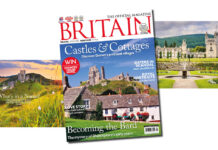
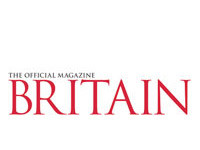
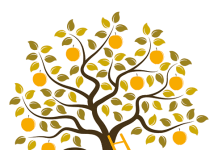

 © 2024
© 2024